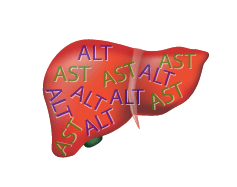
Liver enzymes are enzymes –
Liver enzymes are found in the blood normally, but only in a certain range of concentration. When liver enzymes are found in the blood over and above the normal range, that can be an indicator of liver diseases. Although the liver produces a huge number of enzymes (with the possible exception of the brain, it’s arguably the most complex organ in the human body), there are several that are especially important for diagnostic purposes. Some of those follow.
Alanine Transaminase (ALT)
Possibly the single most important liver enzyme for purposes of diagnosing liver disease, alanine transaminase or ALT is measured by a very common blood test. When significantly elevated above normal levels, ALT can indicate damage to liver cells. This can arise from many different causes including physical trauma to the liver, hepatitis, fatty liver disease, early indicators of serious liver problems such as liver cancer or cirrhosis, congestive heart failure, diabetes, bile duct blockage, and mono. Obviously not all of these are liver diseases.
Because of the wide range of problems that elevated ALT can indicate, follow-
Aspartate Transaminase (AST)
Another very important enzyme for diagnosis is aspartate transaminase or AST. AST is found in the heart, skeletal muscles, brain, kidneys, and red corpuscles. Elevated AST can be the result of damage to or abnormalities in any of these, so even more than ALT it’s not a clear and unambiguous sign of liver damage when it’s elevated. However, it usually does indicate some sort of medical problem and trouble with the
heart or brain is also cause for concern. AST is considered a major heart disease marker.
Another common test when diagnosing liver disease is to compare the levels of AST to those of ALT. This ratio can be a sign of hepatitis or liver cancer when it’s above 2.0 (i.e., AST elevated to twice the level of ALT). When the ratio is between 1 and 2, that’s a common sign of cirrhosis of the liver, and when it’s below 1 (i.e., ALT elevated above AST), other liver diseases are indicated.
Alkaline Phosphatase (ALP)
Alkaline phophatase is primarily found in the bile ducts and the liver cells that line the bile ducts. For that reason, elevations of alkaline phosphatase can show obstruction of the bile ducts or other problems impeding the flow of bile from the liver to the duodenum, although it also is an indicator of several other liver diseases. However, higher-
and some other people who are showing high rates of tissue growth especially of the bone tissues.
Gamma Glutamyl Transpeptidase (GGT)
This enzyme’s elevation is a more reliable indicator of liver disease than ALT, which is preferentially used as a first-
5′ Nucleotidase
Another follow-
Lactate Dehydrogenase (LDH)
This enzyme is a product of tissue breakdown anywhere in the body, so it’s not a specific for liver disease, and a test for elevated LDH has a lot of uses in medicine and diagnosis. It’s particularly good as an indicator of cancer, since cancer cells are more prone to breakdown than healthy cells. So this is a very broad diagnostic indicator and its primary utility in liver disease diagnosis is that, once liver problems have been identified by other tests, elevated LDH is an indicator of liver cancer rather than other liver diseases.